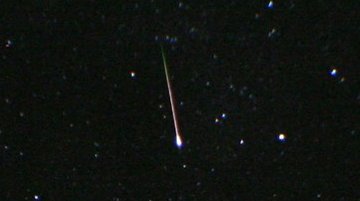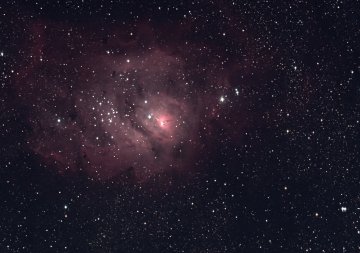 Where's Saturn? Is that a UFO--or the ISS? What's the name of that star? Get the answers from mySKY--a fun new astronomy helper from Meade. Where's Saturn? Is that a UFO--or the ISS? What's the name of that star? Get the answers from mySKY--a fun new astronomy helper from Meade. AURORA WATCH: Earth is exiting a solar wind stream that produced mild geomagnetic storms yesterday. Bright auroras tonight are unlikely. ORIONID UPDATE: The Orionid meteor shower caused by dust from Halley's Comet peaked this morning, but it was not the bright display hoped for by many sky watchers. "The meteors I saw were mostly faint and very fast," reports Brian Emfinger of Ozark, Arkansas. "There was one exception--this Orionid was bright and nearly straight overhead:" 
Photo details: Canon Digital Rebel XT, ISO1600, 30s
Earth is now exiting Halley's dust stream and the shower should subside to even lower levels in the nights ahead. Don't be surprised, however, if an occasional Orionid straggler lights up the sky between now and the end of October. more images: from Rob Ratkowski of Haleakala Summit, Maui; from Chris Peterson of Guffey, Colorado; from Marsha Adams of Sedona, Arizona FIND THE ASTEROID: One of the stars in this photo is an asteroid. Can you find it? 
"What a really sweet sight!" says photographer Mike Holloway of Van Buren, Arkansas. "Asteroid Vesta is moving just south of the Lagoon Nebula for the next couple of days." The Lagoon Nebula is a massive cloud of interstellar gas where young stars are being born. Vesta is an old space rock left over from the formation of our Solar System 4.5 billion years ago. The nebula and the asteroid, seemingly so different, are both keystones of star formation. (At this very moment, a NASA spacecraft named Dawn is en route to Vesta to find out what it can tell us about star-genesis.) Amateur astronomers, if you wish to photograph this encounter, set your goto telescope to these coordinates: (18h 4m 34s, -24o 16'). The Lagoon Nebula is located in the constellation Sagittarius, almost due south after sunset. The Lagoon Nebula is 6th magnitude, Vesta is 7th magnitude.
October 2007 Aurora Gallery
[September Gallery] [Aurora Alerts] | 
